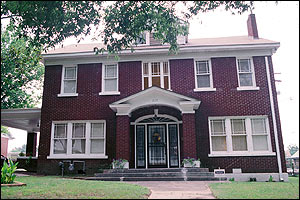Listed in Arkansas Register of Historic Places on 09/02/98
SUMMARY
The Edward B. Downie House is being nominated to the Arkansas Register of Historic Places under Criterion C as a good example of a Colonial Revival style house with Craftsman details. The house is also eligible for recognition under Criterion B, for its association with Edward B. Downie a prominent Little Rock lawyer and judge. The residence exhibits such Colonial Revival-style features such as: an accentuated front door with a fanlight and side lights, a symmetrical facade, and cornice returns. Craftsman-influenced features include the geometric-patterned windows, the large brick columns supporting the porches, and the rustic stone retaining walls. The property is ineligible for the National Register because of the artificial siding in its gable ends and soffits.
ELABORATION
Edward Downie is the most well-known of the house's historic residents. Downie, a prominent lawyer in Little Rock during must of the early part of this century, lived in the house from 1921 to 1945. He was born in 1885 in Kansas. His parents ioneers who raised livestock. He was very poor growing up, had polio as a child, and raised livestock.
In 1905, Downie came to Little Rock because of a civil service appointment. He moved into Mrs. Wilson's boarding house on Spring Street on the advice of a friend. The boarding house was only a few blocks from the Old State House, where the night classes for the University of Arkansas Law School were held. The boarding house was consequently inhabited by many law students. Downie became interested in law and received a degree in 1907. He set up a law practice with one of his classmates, which got off to a slow start. He later took a position as private secretary to the United States District Judge for the Eastern District of Arkansas. Within ten years he had established himself as one of the state's leading lawyers, and he bought the house at 2119 West 19th Street.
Downie was the General Attorney for the Arkansas area of Southeastern Bell Telephone Company for more than twenty-five years. In 1917, Downie was chosen to replace a judge temporarily who had fallen ill. He subsequently became a permanent judge and later served on the Board of Central Examiners, which examined all individuals seeking to be lawyers. Eventually, he came to be known affectionately as "the Judge." Downie purchased the home at 2119 West 19th Street from Miriam Long in 1921. He died in 1945 at the age of sixty.
SIGNIFICANCE
The Edward B. Downie House is being nominated to the Arkansas Register of Historic Places under Criterion C as a good example of a Colonial Revival style house with Craftsman details. The house is also eligible for recognition under Criterion B, for its association with Edward B. Downie a prominent Little Rock lawyer and judge. The residence is sited outside the Central High Historic District boundaries to the southwest. Although this area is still in a period of decline, it is hoped that the nomination of this home will spark interest in neighboring home owners. The property is ineligible for the National Register because of the artificial siding in its gable ends and soffits.
BIBLIOGRAPHY
Peaker, Ora. Meet the Judge. Meader Press. Boston: 1958.
Interview with Barbara Jones. July, 1998
